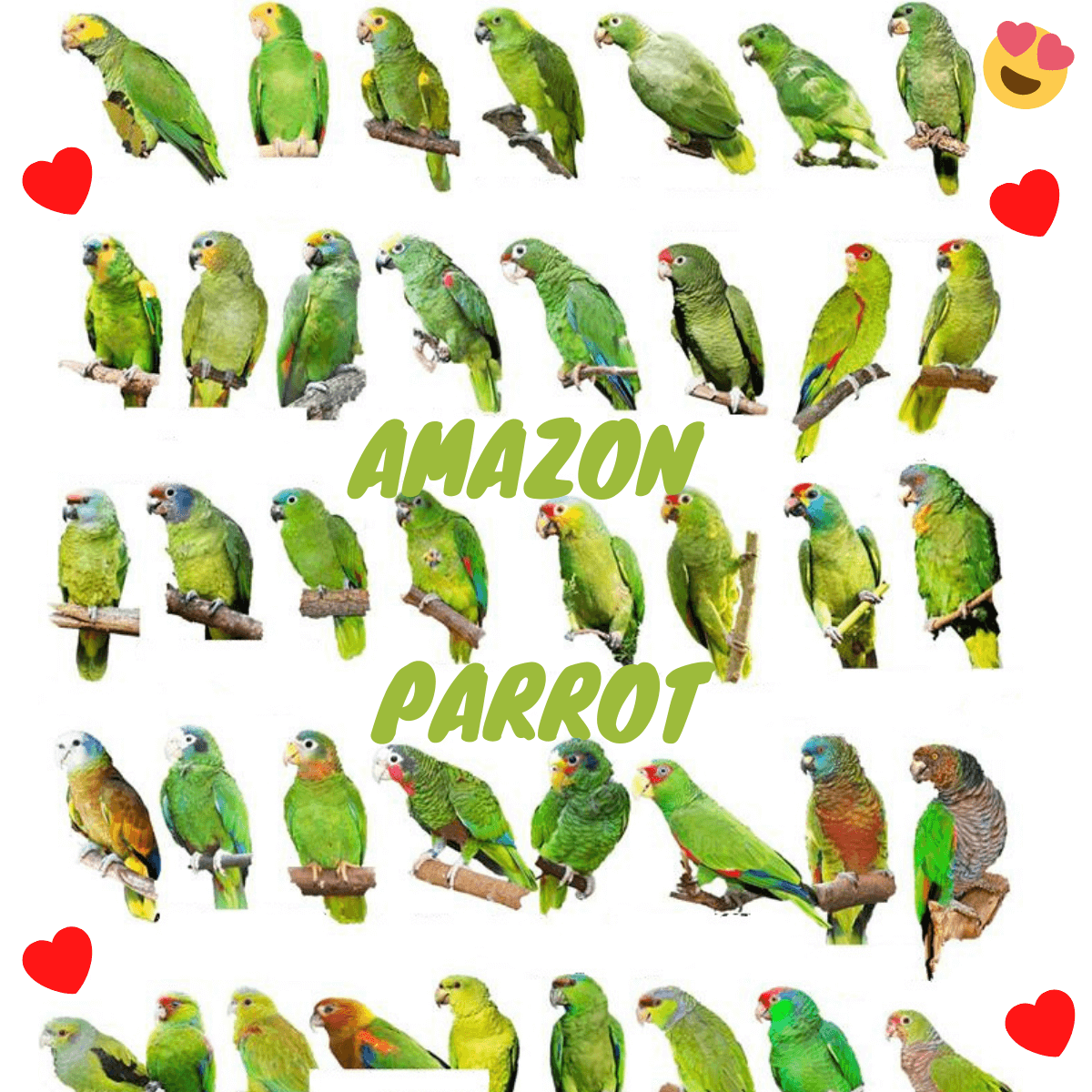
The Amazon parrots ( Amazona ) are with 31 recent species the largest genus of the family of the real parrots (Psittacidae) and the order of the parrots (Psittaciformes). The distribution area of the Amazon parrots extends from southern Mexico and the Caribbean islands to Uruguay and the north of Argentina.
Its main area of distribution is the tropical zones of South and Central America. In addition to rainforests, they inhabit such diverse habitats as savannah and semi-desert areas, arid dry forests and wooded swamps within this large distribution area.
No fewer than sixteen species belonging to this genus are endangered, critically endangered or even threatened with extinction. These are mainly the endemic species found on the Caribbean islands. Large-scale habitat destruction and fishing for trade have severely reduced the populations of some species.
Appearance
Amazon parrots are medium to large sized parrots. The smallest species is the red-mirrored amazon , which reaches a body length of 25 centimeters when fully grown. The Imperial Amazon applies with a body length of 45 centimeters as the largest species of this genus.
One of the noticeable features is the powerful, curved beak , which is connected to the skull in a joint-like manner and which is therefore characteristic of all parrots. In Amazon parrots, the beak is horn-colored, dark gray to black and in one species, the pigeon-necked parrot, even red.
At the base of the beak there is a slightly protruding skin, the so-called wax skin. The tongue, which is provided with tactile bodies, is muscular, the feet are used as a grasping organ. The two middle toes point forward; the first and fourth, on the other hand, towards the rear – this is also characteristic of all parrots.
In the case of Amazons, the skull capsule is also complete, which indicates that they are closely related to the genus of the red-tipped parrots. Another characteristic of the genus is the palate of the Amazons with so-called filing notches. These filing notches sharpen the edge of the lower mandible and are used to hold and chop food.
Characteristic of the appearance of the Amazons are the broadly rounded tail and the broad, likewise rounded wings. Their plumage is predominantly green in color, with red, yellow, or blue color markings on the head, on the wings or on the tail feathers.
Only three color morphs of the king amazon differ more strongly from this typical appearance of the amazons. With these, the basic color of the plumage is golden, red or olive-brown. The eyes of the Amazon parrots sit on the side of the head and can work independently of each other.
All species have a non-feathered eye-ring. It is mostly white, with some species also gray, blue, or yellow in color. Only two species show sexual dimorphism in their plumage: In the case of the red-mirrored amazon, the cover of the hand of the male, which is consistently red, is partly green in the female.
In the Yellow-shouldered amazon, the entire plumage of the female is a little duller and the abdominal plumage is a little less blue than in the male.
The flight of the Amazon parrots is characterized by soft wing beats, the turning point of which is below the body. They also cover short distances in gliding flight, whereby the wings are slightly bent downwards. The flight is often accompanied by loud shouts.

Amazon parrot habitat
The distribution area of the Amazon parrots extends from southern Mexico and the Caribbean islands to Uruguay and the north of Argentina. Its distribution area has a length of around 7500 kilometers and extends mainly to the tropical regions of South and Central America. With equatorial South America, it includes one of the most biodiverse regions on earth.
Within their large area of distribution, the individual Amazon parrots use very different habitats. These range from savannah and semi-desert areas to arid dry forests and wooded swamps. Habitat specialists and generalists can be found within the Amazon parrot genus.
The yellow-shouldered Amazon is one of the habitat specialists and lives in the coastal lowlands of Venezuela in a region that is characterized by dense vegetation of cacti, small trees, and bushes. The red-tailed amazon occurs only in coastal forests and wetlands as well as mangroves in southeastern Brazil.
The Imperial Parrot, which is only found in Dominica occurs only in the local mountain forests from an altitude of 600 m. Other species such as the Miller’s Parrot or the Dufresnes Parrot are so adaptable in their way of life that they can use very different habitats.
In addition to rainforest and cloud forests in Venezuela, the Dufresnes parrot also lives in savannah areas, while in Guyana and French Guiana it mainly occurs in gallery forests.
The distribution areas of the individual Amazon parrots often overlap, so that several Amazon species regularly share the same habitat.
This is what distinguishes them, among other things, from the African ones Long-winged parrots, with which they are not closely related, but with which they display a number of similar behavioral characteristics and occupy similar ecological niches.
The Amazon parrots, which can occasionally even be observed in flocks, include white-fronted and golden-headed amazons; Blue-fronted and Venezuela Amazons as well as Red Mirror and Jamaica Amazons.
Because of their breeding and eating habits, Amazons are dependent on a sufficiently dense tree population. Individual species such as the yellow-cheeked amazon can also be found in more intensively used agricultural regions, provided that they have sufficient trees. They can also develop into agricultural pests. The Blue-fronted Parrot, for example, causes great damage to orange plantations in eastern Argentina.
Sometimes up to 5,000 Amazon parrots invade such plantations at the same time. The blue-capped amazons that live in western Mexico, which live in flocks of two to three hundred individuals outside of the breeding season, are occasionally hunted by humans because they haunt grain fields and banana plantations. Yellow-cheeked amazons cause damage even on coffee plantations.
Nine species of Amazons are restricted in their distribution to individual Caribbean islands. The Imperial Parrot and the Blue-Headed Parrot occur only on Dominica, King Parrot only on St. Vincent, and the Jamaican Amazon on Jamaica.
The smallest Amazonenart, the black-billed amazon comes in Jamaica only in damp mountain forests at altitudes 500 and interlocutory 800 m in front; the very rare Puerto Rican Amazon can only be found on Puerto Rico and a few minor islands.
The blue-crowned amazon originally only lived on Hispaniola and some adjacent islands. In the meantime, however, it has also been introduced to Puerto Rico.
The distribution area of the blue masked amazon is limited to the Caribbean island of St. Lucia. It can only be found there is a single forest refuge, the extent of which is less than 40 square kilometers.
Amazon parrot Behavior
Intensive studies of the behavior of blue-fronted amazons are not available for all species. More detailed insights into social behavior and courtship were also obtained primarily from Amazon parrots kept in large aviaries.
The ornithologist Werner Lantermann , for example, carried out intensive observations on blue-fronted amazons over several years and was able to evaluate the behavior of 22 adult Amazons of this species . More detailed field observations are above all about the Puerto Rico AmazonIntensive efforts are being made in Puerto Rico to preserve them.
On the other hand, relatively little is known about a number of other species: For example, all that is known about the free-range brood of the red-tailed amazon is that it breeds in the tree hollows of palm trees; in the case of the Kawall Amazon, the exact course of the distribution area is unknown.
From previous studies on Amazon parrots, however, we know that these parrots generally behave very similarly. From the fact that adult birds of most Amazon species can be observed in pairs all year round, it has been concluded that they form long-term pair relationships.
Amazon parrots are very social live animals. Adult birds are generally observed in pairs so it can be assumed that they will form long-term pair bonds. They also join together in somewhat loosely structured small groups or swarms. Especially for the Amazon species, which are widespread on the South American continent and the Greater Antilles, sometimes occur in very large schools.
is reported of the magnificent amazon that up to 30,000 Amazons came to the traditional meeting places before the birds went to their sleeping trees in individual groups. Since then, however, due to habitat destruction, the population has decreased too much to form even the largest swarms.
The swarms are loose associations made up of individual family groups. Couples are usually accompanied by one, rarely up to three young birds.
From aviary husbandry, we know that parent birds tolerate their offspring in their immediate vicinity for several months and only drive them out of their immediate surroundings with the onset of the next breeding period with increasingly aggressive behavior.
It is typical for Amazon parrots that live in flocks that they fly in large groups to the feeding grounds and that their nesting holes are often very close to one another. The reason for the association in such flocks could be the reduced risk of being attacked by a bird of prey in such associations.
Two pieces of evidence are cited for this thesis: The Amazon species native to the Lesser Antilles, blue-headed, blue-masked, king, and imperial amazons, show a significantly reduced group behavior.
The same goes for one on the island Cayman Brac living subspecies of the Cuban Amazon, while the group behavior of the subspecies of this Amazon species occurring on the mainland is much more pronounced.
There are no larger birds of prey on either the Lesser Antilles or Cayman Brac.
Nomadic swarms can be observed especially among the Amazon parrots, which colonize open bushland or savannah areas. Unlike the Amazon parrots that live in the tropical rainforest, they have to undertake longer migrations because sufficient food is only available for them after prolonged rainfall.
The peak activity of the Amazon parrots is in the early morning from the beginning of dusk to around 10 a.m. and in the late afternoon from around 4 p.m. to dusk. During these times they undertake their extended flights to find food or to return to their sleeping places in the evening. Reputation is also most pronounced in these times.
Amazon parrot food
Amazon parrots are generally food generalists, consuming a wide range of seeds, fruits, nuts, berries, buds, and flowers. Thanks to their strong beak, Amazon parrots are able to break open hard-shelled fruits.
The Puerto Rico Amazon is one of the typical food generalists, for whom more than 50 different forage plants have been identified.
A few Amazon species show a preference for certain forage crops. These include the magnificent Amazon, on the seeds in their diet to a high degree Araucaria is dependent, and the Tucumán Amazon whose diet mainly from the seeds of alders and Araucaria is.
Reproduction
Young bird of the yellow-cheeked amazon
At the southern end of the Amazon parrot range, in Paraguay and Argentina, the breeding season begins in October and November. In a northerly direction, the beginning of the breeding season is shifting forward, so that Amazon parrots in northern South America only breed in February and in northern Central America in May.
Characteristics
Amazons are rather tall Neotropical parrots with a compact and sturdy build with a massive head, stocky body, wide wings, and short, square tail.
Cages for amazon parrots
Like all parrots, the Amazons are demanding birds in their keeping. Amazons, which are taken into human care as young birds, acquire a certain degree of tameness if they spend the appropriate time and, especially when kept individually, join people in some form.
In contrast to other large parrots, Amazon parrots usually do not develop feather plucking or feather biting in this unspecific attitude. With the onset of sexual maturity – usually between the ages of three and five – there are usually significant changes in behavior.
This includes significantly stronger aggression towards the long-time carer and an increased, very penetrating screaming or shouting. The cage is then often defended against familiar people and with their powerful beaks, the birds are able to bite painfully.
For this reason, Amazon experts John and Pat Stoodley generally advise against leaving toddlers unattended with an Amazon parrot flying freely in a room. From her point of view, keeping a house bird also requires training that is remotely based on the training of a larger domestic dog.
In order to make living together in an apartment and visits to the vet more problematic, it is necessary from their point of view that the bird can be carried around on command on a stick or on the arm of the carer, return to its cage on command or be put down on a seat and remains there.
When flying free in the apartment, nesting sites are searched for in dark corners and behind shelves. Sexually motivated substitute acts such as copulation attempts on the caregiver’s arm or foot can also occur. Occasionally, food is also choked out against people or another partner substitute. This is part of normal courtship behavior in the wild.
Systematics
It is disputed to what extent the yellow-bellied amazon belongs to the Amazon parrots. Chromosome studies suggest that it is very different from the other amazon species and has many similarities with the red-tipped parrots. Their behavior also indicates a different genre.
Their wing beats are faster and the physical development of the young is faster than that of other amazon species. The evolutionary development of the Amazon genus and other New World parrots is therefore described on the basis of chromosome studies as follows:
Amazon parrot types
In addition to the 31 recent species, two other species have been described with the Martinique and the Guadeloupeamazone , both of which have been considered extinct since the beginning of the 18th century.
Its distribution area is said to have been the island of Martinique and Guadeloupe , both of which belong to the Lesser Antilles. Nothing is known about the way of life or a detailed appearance of these two species; there is also a lack of museum bellows .
It cannot therefore be ruled out that these species were Amazon species that are still found on islands in the Lesser Antilles today.
The following are the 31 recent species, the two species considered to be extinct, as well as some subspecies with established German names.
A division into species groups based on similarities in appearance is still common. The findings of the chromosome analysis, which has been carried out since the 1980s, already show different classifications in some cases. Since only 19 amazon species and 41 subspecies have been investigated so far, this investigation cannot yet be regarded as complete:
- Species group 1:
- White-fronted Parrot
- Sonoran White-fronted Parrot
- Lesser White-fronted Parrot
- Blue-winged
- Golden- bridle amazon
- Cuban Amazon
- Western Cuban Amazon
- Cayman Amazon
- Cayman brac amazon
- Bahamian Amazon
- Blue-crowned Parrot
- Jamaican Amazon
- Red-mirrored amazon
- White-fronted Parrot
- Species group 2:
- Puerto Rican Amazon
- Culebra Amazon , extinct since 1912
- Puerto Rican Amazon
- Species group 3:
- Tucuman Amazon
- Great Amazon Parrot
- Pigeon- necked Parrot
- Species group 4:
- Blue-capped amazon
- Red-Crowned Amazon
- Yellow-cheeked Amazon
- Salvin Parrot
- Species group 5:
- Diademed Parrot
- Ecuadorian Parrot
- Species group 6:
- Blue-headed Parrot
- Blue Masked Parrot
- Species group 7:
- Dufresnes parrot
- Granada Amazon or Red-headed Amazon
- Species group 8:
- Blue-bearded Parrot
- Bodinus Amazon
- Blue-bearded Parrot
- Species group 9:
- Soldier Amazon
- Colombia soldier amazon
- Miller’s Parrot
- Guatemala Amazon
- Salvadori’s Amazon Parrot
- Kawall Amazon
- Soldier Amazon
- Species group 10:
- Imperial Parrot
- Species group 11:
- Yellow-headed Parrot
- Yellow-headed Amazon
- Marajó Amazon
- Natterer’s amazon )
- Yellow-headed Parrot
- Yellow-headed Parrot
- Yellow-headed Parrot
- Tres Marías Amazon
- Yellow-naped Amazon
- Red- necked yellow- naped amazon
- Roatan yellow- naped amazon
- Honduras yellow-naped amazon
- Blue-fronted Parrot
- Yellow-winged Bluebird Parrot
- Venezuelan Amazon
- Yellow-shouldered Parrot
- Yellow-headed Parrot
- Species group 12:
- King Amazon Parrot
- Species group 13:
- Red-tailed Parrot
- Species group 14:
- Guadeloupeamazone, extinct since the beginning of the 18th century
- Martiniqueamazone , has been considered extinct since the beginning of the 18th century
- Species group 15:
- Yellow-bellied amazon : meanwhile also Ribeiro parrot and standing between amazon and red- tipped parrots
Related Articles:




















